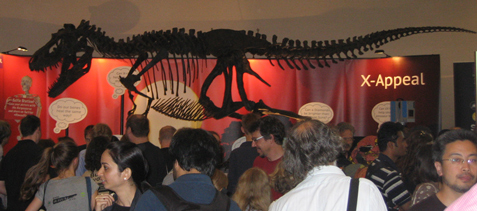Canadian Fossil Discovery Centre Hosts International Fossil Symposium
This week saw the conclusion to the third, bi-annual Manitoba Palaeontology Symposium hosted by the Canadian Fossil Discovery Centre (Morden, Manitoba, Canada). The symposium began in 2007 as an idea to bring palaeontologists and fossil enthusiasts within Manitoba together, to network and discuss a shared interest in the fossils and geology of this province of Canada, a part of the world that contains a number of extremely important and significant fossil sites.
Canadian Fossil Symposium
This symposium was a great success with participants from Manitoba, Alberta, North Dakota and Japan. Ranging from academics, geologists, palaeontologists, students and the general public, curious to learn about some of the new discoveries made about prehistoric life. The research topics presented varied from extinct birds, very appropriate considering the recent work on fossilised feathers discovered preserved in amber in Alberta; the palaeoenvironment of Manitoba eighty million years ago, once again, extremely significant given the Alberta amber fossil study to an analysis of historical railway cuttings exposing fossil beds. These topics were presented either in poster or platform (oral) format by undergraduate and graduate students and researchers.
A Famous Canadian Dinosaur – Gorgosaurus

Providing information on Gorgosaurus to schools. Gorgosaurus mounted exhibit. Picture credit: Everything Dinosaur.
Picture credit: Everything Dinosaur
This year was the first time that the symposium included an international field trip. James Bamburak of the Manitoba Geological Survey and John Hoganson of the North Dakota Geological survey lead a two day field trip to various stops in southern Manitoba and northern North Dakota. The objective was to try and begin to close the gap between the nomenclature (naming) of the rock layers and offer suggestions as to why certain fossils may be seen in one locality and not another across the border. Ammonite fossils were found during the Manitoba leg of the field trip and these fossils were previously unrecorded in Southern Manitoba. A rare bird fossil was discovered in North Dakota, helping to provide more information about the evolution of Aves in this part of North America.
Canadian Fossil Discovery Centre
The Canadian Fossil Discovery Centre’s host committee consisting of Trevor Fehr, Anita-Maria Janzic and Ted Nelson had assistance from the following supporters and sponsors for the event; Town of Morden, Manitoba Geological Survey, North Dakota Geological Survey, Appatoba Barbecue, Canadian Geological Foundation and the Canadian Fossil Discovery Centre. Without this generous support, such events such as this symposium would not be able to take place.
A spokesperson for Everything Dinosaur commented:
“Events such as this symposium are extremely helpful, permitting scientists and researchers to exchange ideas and views on a wide range of topics. It also gives members of the public unprecedented access to important fossil locations and helps build bridges between the scientific community and the wider public”.
The Canadian Fossil Discovery Centre is an important scientific institute in Canada. It houses the largest collection of marine reptile fossils in Canada, including a 43-foot long mosasaur named “Bruce”, the largest mosasaur in the country.
To read an article which highlights some of the marine animals discovered in excavations organised by the Canadian Fossil Discovery Centre: Monsters from Manitoba.
To view models and replicas of Late Cretaceous dinosaurs from Canada: Replicas of Late Cretaceous Dinosaurs and Other Prehistoric Animal Figures.






Leave A Comment